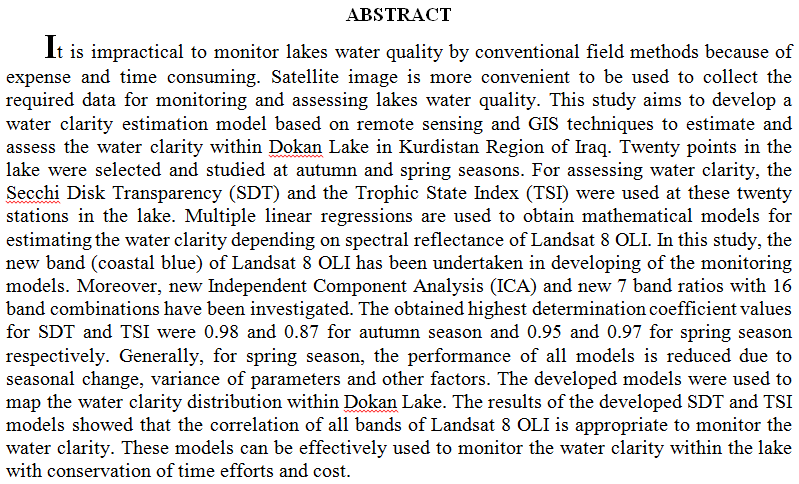
 (6)
(6)
 (5)
(5)
 (6)
(6)
Effluent from incompetent wastewater treatment plants (WWTPs) contains a great variety of pollutants so support water treatments are essential. The present work studies the removal of phosphate species from aqueous solutions by adsorption on to spherical Calcined Sand -Clay mixture (CSCM) used a natural, local and low-cost adsorbent. Batch experiments were performed to estimate removal efficiency of phosphate. The adsorption experiments were carried out as function of pH, dose of adsorbent, initial concentration, temperature and time of adsorption. The efficient removal was accomplished for pH between 10 and 12. The experimental results also showed that the removal of phosphate by (CSCM) was rapid (the % removal 98.9%, 92%, 90%, 89% in 6
... Show MoreBack ground: Zygote produce from once a sperm fertilizes an egg cell. Then, the zygote (unicellular) will begin chain of cellular cleavages to produce multicellular mass, its embryo, the differentiated to different tissues and organism. The development of the embryo is called embryogenesis. Coenzyme Q10, is an antioxidant produced in the body. It boosts cellular energy and may enhance the immune system. CoQ10 is present and measurable in seminal fluid, the concentration of CoQ10 directly correlates with both sperm count and motility. It is beneficial in the prevention and treatment a wide range of health problems. Objectives: The present study was aimed to investigate the possibility of using coenzyme Q10 to improve in vitro fertilization (
... Show MoreBreast cancer is the most diagnosed form of malignant tumour in Iraqi women. Tamoxifen and trastuzumab are highly effective adjuvant therapy for breast cancer. This study's objectives were to define the patient's belief in tamoxifen or trastuzumab when used as adjuvant therapy and to determine the variation in belief between the two medications in a sample of Iraqi breast cancer patients. The cross-section survey was conducted using the BMQ-Specific questionnaire. Ninety-seven participants (sixty-seven tamoxifen, thirty trastuzumab) participated in this study. The mean of specific-necessity scale for tamoxifen was (3.7) and for trastuzumab (4). The findings showed a high necessity for both medicines, and there were
... Show More (9)
(9)
 (6)
(6)
Breast cancer is the most diagnosed form of malignant tumour in Iraqi women. Tamoxifen and trastuzumab are highly effective adjuvant therapy for breast cancer. This study's objectives were to define the patient's belief in tamoxifen or trastuzumab when used as adjuvant therapy and to determine the variation in belief between the two medications in a sample of Iraqi breast cancer patients. The cross-section survey was conducted using the BMQ-Specific questionnaire. Ninety-seven participants (sixty-seven tamoxifen, thirty trastuzumab) participated in this study. The mean of specific-necessity scale for tamoxifen was (3.7) and for trastuzumab (4). The findings showed a high necessity for both medicines, and there were
... Show More (9)
(9)
 (6)
(6)
Breast cancer is the most diagnosed form of malignant tumour in Iraqi women. Tamoxifen and trastuzumab are highly effective adjuvant therapy for breast cancer.
This study's objectives were to define the patient's belief in tamoxifen or trastuzumab when used as adjuvant therapy and to determine the variation in belief between the two medications in a sample of Iraqi breast cancer patients.
The cross-section survey was conducted using the BMQ-Specific questionnaire. Ninety-seven participants (sixty-seven tamoxifen, thirty trastuzumab) participated in this study.
The mean of specific-necessity scale for tamoxifen was (3.7) and for trastuzumab (4). The findings showed a high necessity for both medicines, and there wer
... Show More (9)
(9)
 (6)
(6)
Karbala province regarded one part significant zones in Iraq and considered an economic resource of vegetation such as trees of fruits, sieve and other vegetation. This research aimed to utilize Normalized Difference Vegetation index (NDVI) and Subtracted (NDVI) for investigating the current vegetation cover at last four decay. The Normalized Difference Vegetation Index (NDVI) is the most extensively used satellite index of vegetation health and density. The primary goals of this research are gather a gathering of studied area (Karbala province) satellite images in sequence time for a similar region, these image captured by Landsat (TM 1985, TM 1995, ETM+ 2005 and Landsat 8 OLI (Operational Land Imager) 2015. Preprocessing such gap filli
... Show More (3)
(3)
 (16)
(16)
 (11)
(11)
